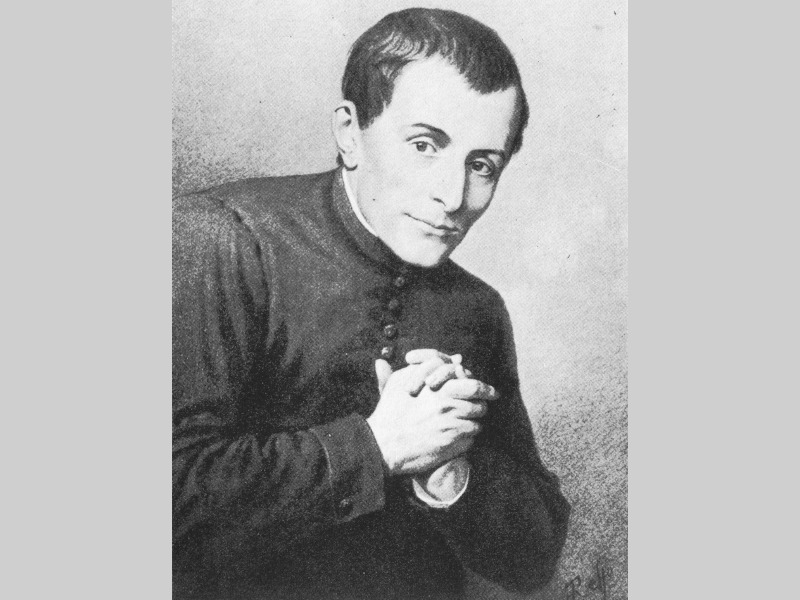
St. Joseph Cafasso – A Saint of Mercy
Mercy lived
Someone said, “True theology is not done by scholars, by professional theologians. Rather it is the saints who, by their lived lives, tell us about God better than anyone.”
In general, this statement may be true of all saints. But some, in particular, have spoken to us in a clearer, more human and understandable way by their lives and actions.
One of these is the Piedmontese priest St. Joseph Cafasso (1811-1860).
Yes vabbeh … do not look at his image, the result of 19th century piety.
Would you like to get to know him a little?
We’re not going to go through a long and hostile (for some) historical explanation. There are publications for that.
We just want to understand how his life became a most vivid image of God the Father’s mercy.

This picture, was probably painted on the occasion of his canonization by Pope Pius XII in 1947.
It is the visual synthesis of his life, a living icon of Mercy.
Counselor
In the upper left corner, the group of people depicted are some leaders of the city of Turin, whose confessor or counselor he was.
His words were admonition, instruction, and valuable advice.
He was always respectful of everyone’s opinions and life, and throughout his life he was sought out for his true, deep, clear words.
Often those who spoke with him were converted or rooted in holiness.
He did not waste a lot of words, he did not get lost in sophistry.
He was a living reflection of Jesus’ word:
“Let your yes be yes, your no be no. The more comes from the evil one.”
Understanding, gentle but at the same time firm, clear-sighted.
Trainer

Pope Pius XI called him “the pearl of the Italian clergy.”
The second group of people, in fact, are the priests.
From a very young age (22) he was entrusted with the formation of the clergy.
All his life he engaged in teaching theology, especially moral theology, to teach how to transmit divine mercy through the sacrament of confession-reconciliation.
He formed generations of priests and bishops with a father’s heart.

He knew well that priests and bishops were the formators in turn of the Christian people.
That is why he teaches them to become wise counselors.
Not know-it-alls and cold transmitters of a doctrine, but living images of the Father’s mercy.
Friend of the poor
In the lower left corner other important recipients of God’s mercy are depicted: the poor and destitute.
No one ever walked away from him empty-handed.

With the imagination and daring of true friends of God, Joseph Cafasso always found something to give to fill the needs of those who approached him with some legitimate request.
In his time, the city was beginning to experience internal immigration from the surrounding countryside.
It was easy to get swallowed up by the capitalist world.
As today, it took only a little to fall behind and be forced to beg.
Gallows priest
Finally, at lower right, the practice of mercy that made him the “Patron Saint of Italian prisons”: visiting prisoners.
They were terrible places and the prisoners were in horrible conditions.
This was because the death penalty by hanging was in force at the time. Those who were destined for it were certainly not treated with consideration.
Turin, the industrial capital, was filled with people who tried to make a living but were often forced into crime. People also died for stealing apples, stolen out of hunger….

Joseph Cafasso was not afraid to enter those unhealthy, dirty and smelly places, crammed with sore and often angry people who spoke only in dialect.
He climbed into the carts of those condemned to death, made the journey with them from the prisons to the place known as the “gallows traffic circle,” trying to wring out at least one last wish for redemption, a sigh of repentance, a prayer.

He would not give up until he had obtained it.
Then, he would write to the families, comforting them, telling them how their son or husband or brother had died in God’s grace.
In summary

These are the four pillars of the life of St. Joseph Cafasso, a living icon of divine mercy: counselor, formator of the clergy, father of the poor and comforter of the condemned and imprisoned.
His life, his example, his teachings reveal something important to us: without being exceptional people, it is possible to embody the Gospel of mercy.
It is possible to offer our poor lives as a vessel for the merciful love of a God who gave his life for us.
The only way to show God that we love him is to love those around us. Simple, or is it?
Images
- Wikipedia.org
- Marco Chiolerio
Sources
- Marco Chiolerio
